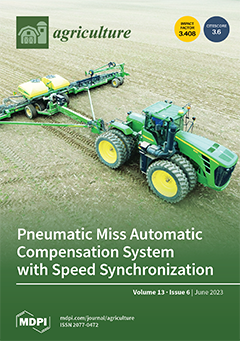The application of fungicides in maize by the commonly used overhead spraying technique is more challenging than in small-grain cereals. Especially in later development stages, when the plant has reached a considerable height, lower plant organs (e.g., ears) may be insufficiently protected, since
[...] Read more.
The application of fungicides in maize by the commonly used overhead spraying technique is more challenging than in small-grain cereals. Especially in later development stages, when the plant has reached a considerable height, lower plant organs (e.g., ears) may be insufficiently protected, since a large part of the applied fungicide is deposited on the upper leaves. In contrast, lower plant organs can be reached by the dropleg spraying technique, which allows sub-canopy applications. This study investigated the efficacy of fungicide applications during flowering in forage maize using the overhead and dropleg spraying techniques as well as a combination for the control of
Kabatiella zeae and mycotoxin-producing
Fusarium species, which can affect leaves and ears, respectively. The efficacy was evaluated in field trials under natural
K. zeae and artificial
Fusarium inoculum conditions in Northern Germany by measuring disease severities of
K. zeae on maize leaves, dry matter yields, and concentrations of the
Fusarium mycotoxins deoxynivalenol (DON) and zearalenone (ZEN) at harvest.
Fusarium inoculations of main ears at full flowering resulted in significantly higher DON and ZEN concentrations compared to natural
Fusarium infections, whereas the dry matter yield was not affected. The strongest disease progressions of
K. zeae were determined after flowering on the upper leaves and leaves around the main ear. Disease severities were significantly reduced on the upper leaves by the overhead application and the combination of the overhead and dropleg spraying technique, whereby the three spraying techniques were equally able to decrease the infestation on the yield-essential leaves around the main ear. No differences in dry matter yield were found between the application techniques, but they were significantly higher than in the untreated control. The contamination with DON and ZEN was most effectively reduced by sub-canopy applications using the dropleg technique, whether as a solo application or in combination with the overhead technique. The main ears were reached better with the applied fungicide, reducing
Fusarium infections, and therefore, contamination with mycotoxins. The dropleg technique offers an opportunity for improved protection of lower plant organs, especially in tall growing crops. In combination with the overhead spraying technique, the protection of various plant organs along the entire plant with the applied fungicide could be advantageous, especially when different parts of the plant are affected by different fungal diseases.
Full article





